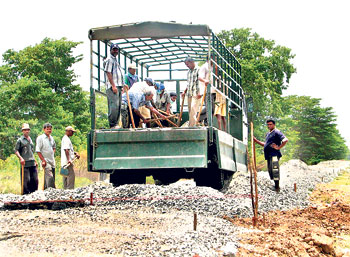| Indian Railways with over 63,000 kilometres of rail track at home is one of the largest mass transport networks in the world. And, laying down 90 kilometres of track in Sri Lanka’s northern province might therefore be an easy task for the organization. But, the Omanthai-Pallai track project costing $185 million is of significance to New Delhi given that it is a major infrastructure reconstruction programme in post-war Sri Lanka.
Apart from multi-lateral lending agencies such as the World Bank and Asian Development Bank (ADB), India has provided large grants to Sri Lanka for reconstruction works. China however has been seen as grabbing plum infrastructure projects by extending its line of credit even at commercial rates to the island nation in various sectors including military supplies. China’s expanding interests in the Indian Ocean region has deepened India’s concerns.
 |
| Constructions begin at a completely destroyed rail track near Omanthai |
The Government of India’s firm Indian Railways Construction Company (IRCON) with over three decades of work experiences in India and other countries has picked up the Omanthai-Pallai project which is of diplomatic importance to New Delhi as Beijing had been waiting at the door. Another $240 million from the Indian line of credit is expected to arrive in Colombo in the near future when two other track programmes are finalised between IRCON and Sri Lanka Railway.
According to sources in Colombo’s diplomatic community, China was in the reckoning for the coming up Medawachiya-Madhu road-rail link project but India seems to have finally bagged that contact along with another to build the Madhu Road to Tallaimannar track. Sources also said that India offered to develop rail lines at around $2 million per kilometre as compared to a much higher price quoted by China.
A rail link between Omanthai and Pallai earning high revenue for Sri Lanka Railway had existed till 1989. While the track was officially closed that year as tensions between the LTTE and Sri Lankan government forces brew; in subsequent years even metal welds fitted alongside the tracks had been removed and the line debilitated. IRCON officials who conducted a survey of the terrain for two months prior to signing the agreement, said, the area was still to be demined completely.
Trains would be able to touch even 120 kilometres per hour on the northern line due to a flat surface unlike the Island’s undulated south where speeds are usually kept below 100 kilometres per hour. IRCON will fetch 50 of its track laying machines from Africa’s south eastern country Mozambique where a civil war was fought for 15 years and where IRCON recently completed 600 kilometres of rail routes.
Sister organization, the Rail India Technical and Economic Services (RITES) will provide training to the local rail workers. “RITES will bring in a few officers and engineers from India to train Sri Lankan workers. We have been doing this in the south as well,” general manager (Sri Lanka), IRCON International Ltd., told the Sunday Times.
Employment of local workers in infrastructure programmes is another area where Indian and Chinese economic engagements in Sri Lanka appear to differ. Sources in Colombo’s diplomatic community said that while the Government of India was keen on having maximum number of local workers on such projects, China brought in its own labour to work here.
IRCON began the modern reconstruction of the 2004 Tsunami-affected Matara-Colombo rail line in March last year. With 14 officers from India working in its Colombo and Galle offices, RITES has trained 40 local engineers and workers for the southern line. Already 42 kilometres of track reconstruction between Matara and Galle has been initiated by IRCON and the second phase of the programme which includes rebuilding 71 kilometres track from Galle to Kalutara will soon be undertaken by it. India sanctioned a grant of $167 million for the southern line. |


